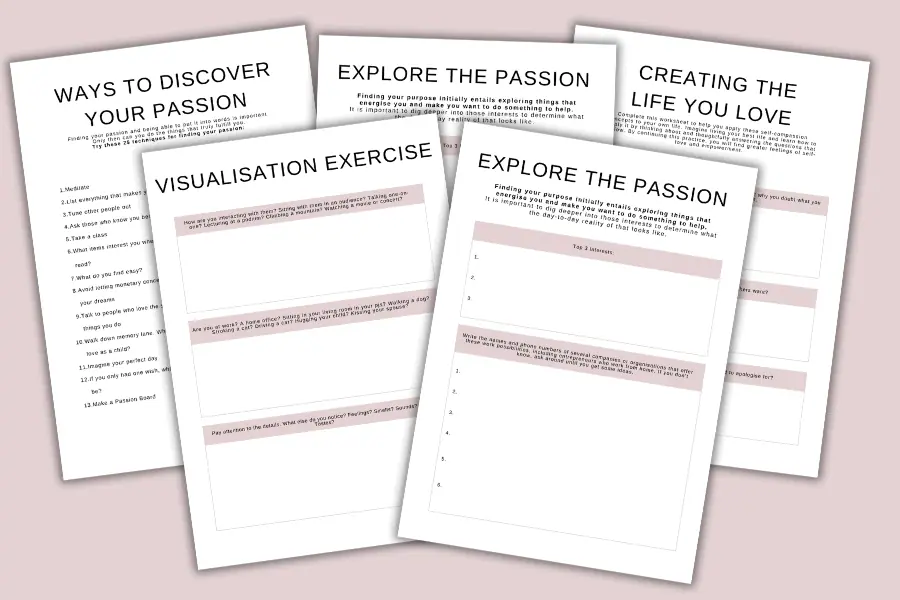What To Do When You Feel Stuck In Life

Have you ever found yourself wondering, “Is this all there is to life?” You wake up, follow the same routine, and then go to sleep, only to do it all over again the next day. If this sounds familiar, you’re not alone. Many of us hit a point where life feels like a never-ending loop of the same old patterns. It’s like being stuck in a dull grayscale world while longing for a burst of colour.
But what if I told you that feeling stuck isn’t the end but a beginning? That it’s a hidden signal from your life urging you to pause and pivot, not to stop and surrender.
In this post, we’re diving deep into why you feel stuck and what you can do to break free from this rut. From understanding the root causes of your stagnation to implementing a step-by-step plan that injects excitement and purpose back into your life, we’ve got you covered.
This blog post is about what to do when you feel stuck in life

Why You Might Feel Stuck
One of the first steps to discovering what to do when you feel stuck in life is looking at why you might feel stuck.
Once you pinpoint the route of your feelings, it becomes easier to tackle.
Midlife Transition
Many people go through a midlife transition, not necessarily a crisis. It’s a time when you might evaluate your achievements, goals, and the direction your life is taking. This can often lead to feelings of dissatisfaction if your current reality doesn’t align with your expectations or ambitions.
Routine and Comfort
While a stable routine can provide a sense of security, it can also lead to monotony. If your daily life lacks variety or challenge, it might feel like you’re just going through the motions, which can diminish feelings of personal growth and excitement.
Comparison with Others
With the rise of social media and more outward sharing of personal success, it’s easy to fall into the trap of comparing your life to others. This can amplify feelings of being behind or not achieving enough, even if your own life is quite fulfilling in its own right.
Unclear Goals or Passions
Not having a clear idea of what interests or passions to pursue can make you feel directionless. Without these, it can be hard to find motivation or a sense of purpose.
Overwhelm and Burnout
Sometimes, feeling stuck can be a symptom of underlying stress or burnout. This could be due to work, personal responsibilities, or other pressures that leave little time for self-reflection or relaxation.
Take the time to evaluate your life, going through all aspects; work, relationships, hobbies and everything in between – including bad habits!
Why Action Is Important
When you feel stuck, your daily routine can feel really overwhelming. However, initiating even small actions can create momentum, breaking through the mental barriers of stagnation. Being proactive is about taking responsibility for your own life and making deliberate choices toward a more fulfilling future.
Start Small
You don’t need to start making huge changes. Sometimes, small, consistent steps are what lead to significant change.
Create Momentum
Each small action can build momentum. Like a snowball rolling downhill, the more you do, the easier it becomes to keep moving.
Shift in Mindset
Taking action can shift your mindset from one of helplessness to one of empowerment. This shift is crucial as it changes how one views life’s challenges—from obstacles to opportunities.
Step-By-Step Action Plan
To effectively tackle the issue of feeling stuck, it’s essential to have a clear and structured plan. Here are the steps to consider:
Self-Assessment
Start by taking stock of your current situation. Identify what areas of your life feel stagnant and why. Consider using tools like journaling or mind maps to better visualise and understand your thoughts and emotions.
Goal Setting
Establish clear, achievable goals based on your self-assessment. These should be Specific, Measurable, Achievable, Relevant, and Time-bound (SMART). These goals can cover any area of your life, you just need to be specific and clear with your goals.
Plan of Action
For each goal, outline specific actions or steps needed to achieve it. This might include scheduling, resource allocation, or breaking down larger goals into smaller, more manageable tasks.
Implementation
Begin taking the planned actions. Start with easier tasks to build momentum and confidence.
Monitoring and Adjustment
Regularly review your progress. Be prepared to adjust your goals and actions as needed based on what is or isn’t working.
Overcoming Challenges
When attempting to break out of a rut and make significant changes, several challenges can arise:
Lack of Motivation
Often, the initial excitement of setting new goals can wane, leading to a loss of motivation.
Fear of Change
Stepping out of your comfort zone can be daunting. Fear of the unknown and fear of failure are significant hurdles.
Time Management Issues
Finding time for new activities can be challenging, especially when balancing work, family, and other responsibilities.
Overcoming Challenges
Here are some strategies to help address and overcome these common challenges:
For Lack of Motivation:
- Set Clear, Achievable Goals: Small wins can significantly boost motivation, so break larger goals into smaller, achievable steps.
- Visualise Success: Spend time visualising the benefits of achieving your goals. This mental rehearsal can keep motivation high.
- Reward Yourself: Create a rewards system for when you accomplish a step or reach a milestone.
For Fear of Change:
- Educate Yourself: Understanding the potential benefits of change can reduce fear. Read stories of others who have successfully made similar changes.
- Start Small: Begin with less intimidating changes to build confidence before tackling more significant challenges.
- Embrace Failures as Learning Opportunities: Shift your perspective to view failures as necessary steps towards learning and growth.
For Time Management Issues:
- Prioritise Tasks: Use tools like the Eisenhower Box to prioritise tasks based on urgency and importance. This helps manage your time better by focusing on what truly matters.
- Schedule Time for New Activities: Just as you would schedule a meeting at work, block out time in your calendar for new activities or steps towards your goals.
- Use Technology: Leverage apps and tools that help with productivity, such as timers for focused work periods (Pomodoro Technique), task management apps, or calendar apps that sync across all your devices.
Round Up
Now that you’re equipped with these tools and knowledge, it’s time to take the first step. Choose one small action from the plan we discussed and commit to it today. Whether it’s jotting down your feelings to identify patterns of stagnation or setting a simple goal for the week, the important thing is to begin.
Taking action can transform the way you feel about your life. Each step you take builds momentum, leading to greater fulfilment and joy. So, start today and watch how small changes can lead to significant transformations.
This blog post was about what to do when you feel stuck in life
Share this post: on Twitter on Facebook



